| Please access the following URL if you want to secure using SSL. All pages in the site will be secure pages. |
| https://secure02.blue.shared-server.net/www.fish-food.co.jp/message english 4.2020.html |
Welcome to FISH FOOD TIMES
Apr. 2020 issue No.196

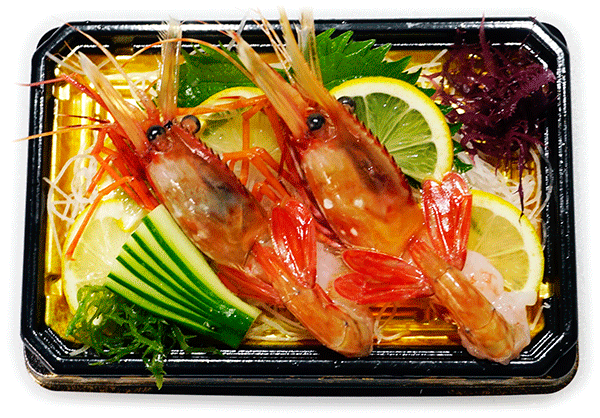
Coonstripe shrimp sashimi
The standard Japanese name for botan shrimp is toyama shrimp
Toyama shrimp (Coonstripe Shrimp) is generally distributed under the name of botan shrimp, and it is not the pseudonym after botan shrimp, but this is a true botan shrimp, claiming that it is a real shrimp in some regions.
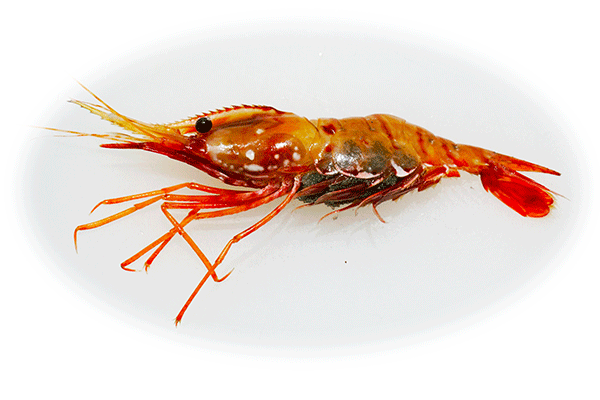
The image below is a real botan shrimp as a standard Japanese name, which is distributed under the name of "true botan shrimp".
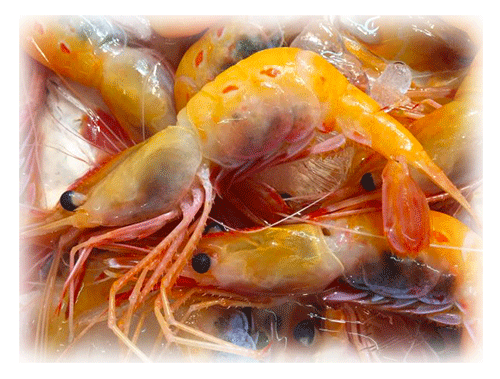
Both belong to the genus Pandalus, belonging to the family Pandalidae, and the botan shrimp (Coonstripe Shrimp) is scientific name Pandalus hypsinotus, English name Coonstripe Shrimp, and the botan shrimp is scientific name Pandalus nipponensis, English name Botan Shrimp.
The difference between the true botan shrimp and the botan shrimp (coonstripe shrimp) is that the botan shrimp has a darker red color overall and dark brown stripes on the abdomen and legs. And the midline ridge of the carapace part, which is the center of the back, is higher than true botan shrimp.
True botan shrimp do not inhabit the Sea of Japan side, and seemed to have been caught in the past in Tokyo Bay off the coast of Miyagi Prefecture and Tosa Bay in Kochi Prefecture, but now only a little in Suruga Bay in Shizuoka Prefecture. It has become a rare species that can only be caught, and it is a shrimp that has deviated from commercial distribution as a fish species for distribution in fisheries. However, botan shrimp were caught in the northern part of the Sea of Japan, off Kushiro, in the Sea of Okhotsk, etc., and off eruption bay in Hokkaido, the main fishing ground, caught 253�d in 2018. As shown in the graph below, the amount of resources seems not bad, and the amount of resources is considered to be at a medium level.
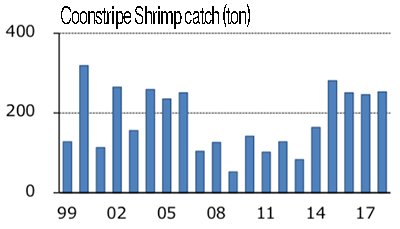
Botan shrimp in Funka Bay live in the sea area at a depth of 80 to 100m, molt twice a year in spring and summer until the age of 1 year after spawning, grow up to 1 year old as a male, and then 75% in the winter of 2 years old sexually change to female. In other words, they are all male when they are young, and at a certain age, most become females and concentrate on child-rearing and raising children. This interesting and strange phenomenon is called protandry. Males then grow in the winter and females molt once a year in the summer, mating and incubating during this molt. And the incubation period shown in the image below is very long, and it seems to extend to 6 to 7 months.
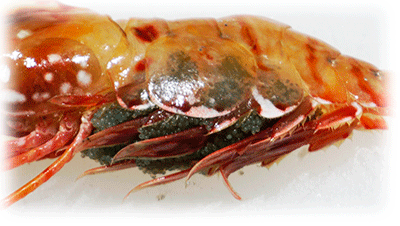
At the peak of the spring fishing for shrimp cages in Funka Bay, the first image is a botan shrimp that was caught in Funka Bay in late March and sent in a fresh and fresh state. Eating fresh botan shrimp with sashimi or sushi is very luxurious, and the sticky sweetness contained in its transparent body is still exceptional.
Raw botan shrimp are treated as luxury goods in the market, and the price depends on the size and freshness, but since one fish costs at least 200 yen, it is one of the similar red-colored shrimp argentine red shrimp about 10 times. Due to the high price, they are rarely lined up in supermarket fish counters, and are mainly purchased by business sources such as high quality restaurants and high-end sushi restaurants.
Taka shrimp, also known as red shrimp in southern Kyushu
Botan shrimp are expensive and difficult to buy, but do you know that red shrimps are also caught in Kagoshima in southern Kyushu and can be obtained at very reasonable prices?
The shrimp name is the local name Taka shrimp and the standard Japanese name is higenaga shrimp. Fishing is prohibited from January to March every year, and the open season starts in April.
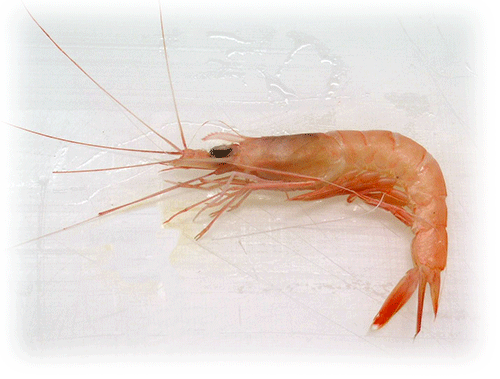
The name higenaga shrimp seems to be named because the tactile beard is very long as shown in the image, and in Kumamoto it is also called red shrimp because of its red color. This shrimp belongs to the family Solenoceridae, and is eaten mainly on raw food in Kagoshima, but for some reason the price seems to be traded at a relatively low level. I don't understand why it's because it has a little more water than botan shrimp, or because it's hardly known locally because it's rarely distributed throughout the country.
The image below shows a fish section of a company that I had instructed more than 10 years ago. At that time, the shrimp were sold at such a large volume and at a low price, but it seems that the price situation has not changed much.
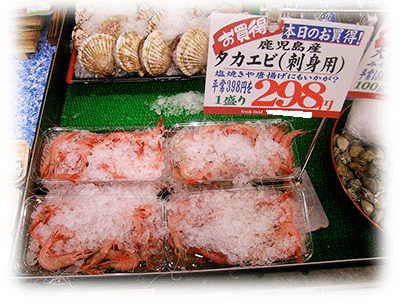
And this shrimp can be sold at a price of 380 yen per pack if it is sashimi as shown in the image below, so it is thought that even if the selling price is low, the markup ratio will be able to secure an extremely high level.
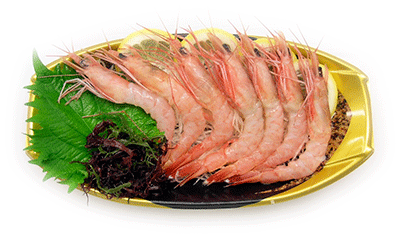
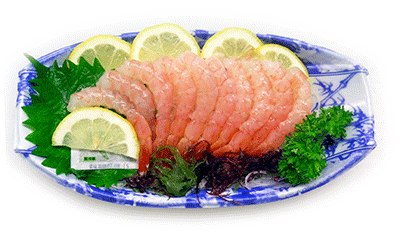
Taka shrimp must be a "delicious shrimp" in the business for the fish section of Kagoshima.
Argentine red shrimp, formerly called botan shrimp
This red shrimp lives in the sandy bottom at a depth of 200-600m and is caught by the deep-sea seine net. A member of the Solenoceridae family to which taka shrimps belong is the Argentine red shrimp (hereinafter referred to as AR red shrimp), which has the same red color and is now counted as one of the representative shrimps in the fish section.
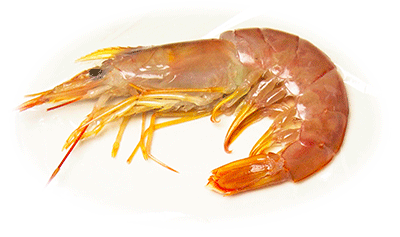
Previously, the catch of AR red shrimp was not as stable as it was now, and fishing and fishing were repeated vigorously year after year. Before the 2000s, this shrimp was also called “Olympic shrimp”. Was sold in Japan under the name "botan shrimp". The botan shrimp belongs to the family Pandalidae, and is a different species from the AR red shrimp of the family Solenoceridae. This was a time when AR red shrimp were once a religion that could not be relied on as a seafood product, and of course this is no longer the display.
In FISH FOOD TIMES, AR red shrimp was taken up in the December 2013 issue No.120. Almost seven years have passed since then, and the environment surrounding AR red shrimp has also changed a lot, so I would like to write about AR red shrimp below from a slightly different perspective.
Speaking of 2013, AR red shrimp was just beginning to land on a stable landing.At that time, even though I proposed to sell more AR red shrimp to the fisheries department of the instructed company, It was when the department representatives had not yet readily agreed.
In Argentina, the AR red shrimp landing volume has been able to stably exceed 200,000 tons annually for about three years until last year, and the catch has almost doubled three to eight years ago. According to the Ministry of Finance's trade statistics, the import volume of AR red shrimp in Japan for the year 2019 was 7.8% higher than in 2018, about 16,000 tons, and it seems that it has become a stable imported shrimp product.
Now that AR red shrimp is in this situation, it is seen as an important commodity indispensable in the fisheries sector, and It is thought that the fish section is required to make full use of these.
The biggest advantage of AR red shrimp is raw food, which can be used for sashimi and sushi. Although it is a frozen shrimp imported from Argentina on the far side of the earth, it can be said that it has the same strength as expensive botan shrimp and fresh raw taka shrimp.
For example, as shown in the image below, with such a simple selling method often seen in the fish section of the store, even if the purpose for salt grilling is achieved, it can not get any more added value, the goodness of AR red shrimp can hardly be used.
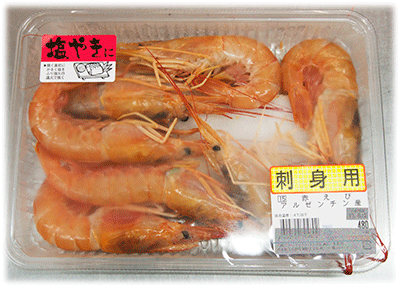
If you want to sell it for raw food, you want to increase the value like this at least in the case of sashimi alone.
| Headless AR red shrimp devein shrimp product | |
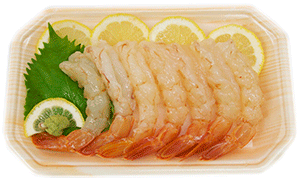 |
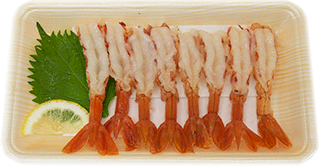 |
| Entering 7 | Entering 8 |
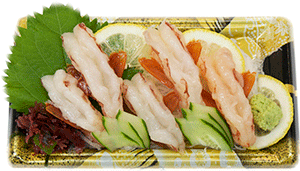 |
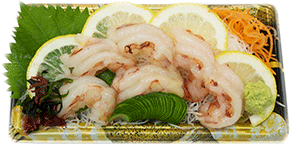 |
| Entering 5 with radish ken | Entering 6 with radish ken |
And in this case, the added value of the sushi single item increases.
| AR red shrimp nigiri sushi | |
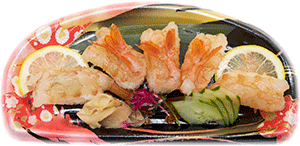 |
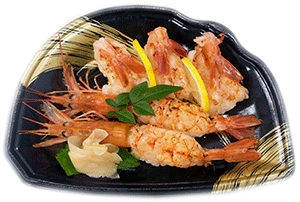 |
| Entering 5 kan | Entering 5 kan with figure nigiri sushi |
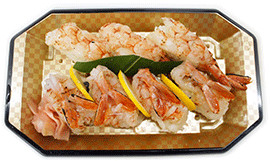 |
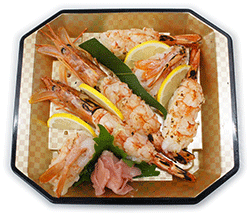 |
| Entering 7 kan | Entering 6 kan with broiled figure nigiri sushi |
xample of assorted sashimi using AR red shrimp
| assorted sashimi using AR red shrimp | |
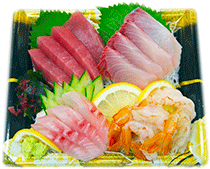 |
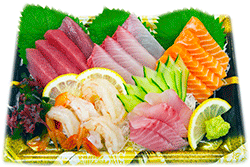 |
| Entering 4 | Entering 5 |
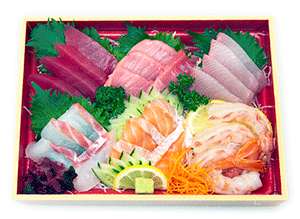 |
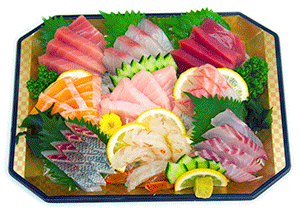 |
| Entering 6 | Entering 9 |
Finally, in the case of assorted sushi using AR red shrimp, let's do it like this.
| Assorted sushi using AR red shrimp | |
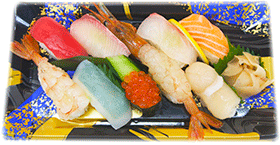 |
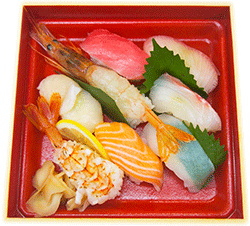 |
| Entering 9 | Entering 8 |
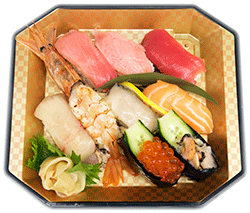 |
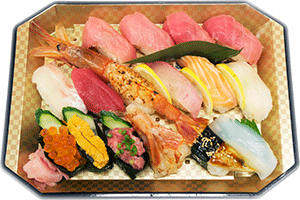 |
| Entering 9 | Entering 16 |
Make more use of AR red shrimp
Despite mentioning botan shrimp, I had to mention AR red shrimp for a long time, but this was not accidentally derailed, it was drawn from the beginning in my head It is an intentional flow.
This is because it is not possible to commercialize so many products using expensive botan shrimp, and I have never actually done so many types of botan shrimp. If botan shrimp can be purchased at a low level, comparable to AR red shrimp, you can do exactly the same with botan shrimp. So you just need to consider the AR red shrimp in the product as botan shrimp.
However, it is unlikely that botan shrimp that are caught in Japan will be at the same price as AR red shrimp unless botan shrimp resources change in the future. After all, the resources of botan shrimp in Funka Bay are considered to be medium level at 256 tons, and since AR red shrimp are being caught more than 200,000 tons every year, there is a difference of three orders of magnitude 100 times the amount of resources.
Argentina has been able to consistently catch more than 200,000 tonnes of AR red shrimp every year, overcoming the uncertainty of landing during what was called the Olympic shrimp. In addition, exporting to the world in an easy-to-thaw form called semi-IQF, and selling freshness that can be eaten raw can be regarded as a revolutionary and great value-added product.
Botan shrimp is an endemic species of shrimp that can only be caught in Japan and is definitely a very delicious shrimp. However, the absolute amount is too small, the price is not very common shrimp, and its position will not change for the foreseeable future.
On the other hand, AR red shrimp continue to be priceless and it is a waste to not take full advantage of this product. If you only modify the chot, you can create a great deal of added value, so I hope that your store will also offer valuable products based on the product models listed above.
| Please access the following URL if you want to secure using SSL. All pages in the site will be secure pages. |
| https://secure02.blue.shared-server.net/www.fish-food.co.jp/message english 4.2020.html |
An opinion and the communication are to iinfo@fish food times
Date of updating 1 Apr. 2020
